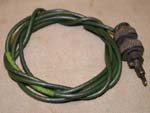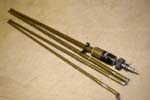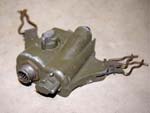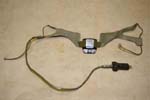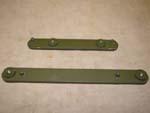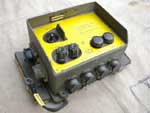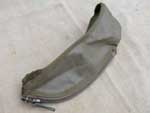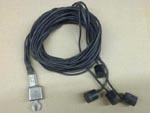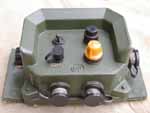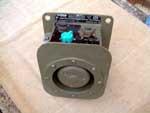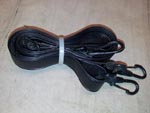The T-45 microphone is a carbon type Noise Canceling microphone designed for operation on a nominal current of 50 miliamps. The resistance of the unit is between 50 and 125 Ohms at 1000 cycles per second. Frequency response is substantially flat from 200 to 4000 cycles per second. The microphone is worn close to the operator
The pouch has two belts or yoke loops and four female press studs on rear. Four press studs on the front to safely lock the radio into position. Velcro flap for quick access and an adjustable quick release buckle.
Approximate Size 4 Wide, 8 Long and 2 Deep. Supplied in very good used condition. NSN: 8465-99-978-7651.
Supplied in good condition considering they are about 60 years old, supplies are limited.
The units are supplied as a pair, one MA-4230A Morse Encoder and one MA-4231 Morse Decoder and in very good condition, like new.
The MA-4230A Morse Encoder Unit enables a message to be transmitted in Morse code. The Morse message is entered using an alpha-numeric keyboard therefore no knowledge of the Morse code is necessary to operate the unit. The MA-4231 Morse Decoder decodes the Morse code being received and displays it one letter at the time on its red dot matrix display or sends it to a printer. Both units are powered by an internal rechargeable battery which provides approximately 16 hours use without recharging. The case fully sealed and waterproof.
Message entry is done via the keyboard which contains forty three Arabic alpha-numeric tactile keys, including SP space and seven function keys. Three indicators are provided showing when power is available, data is being emitted, and when the store is nearly full. The power indicator extinguishes when the battery voltage is low, and when the unit is switched off.
1024 character, non-volatile electronic memory Message store, Normal Transmission speed of 15 w.p.m. and High Speed 120 w.p.m. Keyed Tone Data output - Normal frequency: 1.0kHz. Amplitude: 20mV ? 3dB from 300 source. Contact closure Data output - normal speed only Contact rating 0.5A max.
Unfortunately these handsets do not have the speaker or microphone elements installed, other than that they are in good condition. Useful to recondition a TS-15 handset which has a bad cable or the rubber is rotting away.
The TUAAM is normally fitted very near the antenna mast base of the vehicle or inside the antenna box typically found on Land Rovers wing. It automatically matches the selected frequency of the radio to the antenna installed in the vehicle to give optimum performance and achieve maximum range with the radio set. All Tuning and matching functions are carried out automatically by sensing the antenna impedance at the required operating frequency. NSN: 5820-99-630-6488.
It is switched on at the Radio Lines Box (RLB) and allows ammunition numbers to monitor the harness intercommunications channel or to be addressed by the commander. The unit has a Press-To-Talk button to permit ammunition numbers to reply by connecting the loud-speaker in to the harness circuit as a microphone!
An internal microphone amplifier inside the AIB raises the output level of the loud-speaker to a level compatible with the other crew box outputs. Volume control of the loudspeaker is controlled by the volume knob on the AIB.
A standard 7-pin Clansman Headset or Handset can be externally connected to the AIB using the socket provided. NSN: 5820-99-633-6562. Supplied in untested condition, Grade 3.
Supplied in new condition.
These radios are supplied in very nice condition and include the test certificate.
The Centronics pin-out is:
Pin-1 Negative & case (GND)
Pin-2 Radio +ve (+28 Volts)
Pin-3 PTT
Pin-19 Panel Bulb +ve (+28 Volts)
Pin-21 & Pin-22 Audio output
Two Clansman 24 Volt 1 or 4 Amp Rechargeable batteries as used with the Clansman PRC-319, PRC-320, PRC-344, PRC-351, PRC-352 radio sets. Or two 14.4 volt 4 Amp Rechargeable Batteries that are typically used with the Clansman PRC-350 radios, or one of each type.
Battery tie down straps with two charging indicator lights and a switch to turn them off is on top of the unit along with the 4-pin DCCU Charging socket. These units are supplied in good used condition, tested and operational. DCCU connecting lead and batteries are available separately. NSN: 6130-99-132-0689
The internal X & Gamma sensor is easily removable and is capable of measuring from 1 Milli Rad per hour up to 1000 Rads per hour.
Six measurement ranges by direct reading on a single scale. The scale is illuminated for night reading.
Overall, it is a very sensitive Geiger counter that is portable and self contained, it is robustly built and designed to take a lot of abuse.
The DOM-410 Counter is powered by two standard 1.5 Volt D cells and is supposed to last up to 16 hours on a fresh set of batteries.
The DOM-410 counter is supplied in very good working condition with-out any accessories. Some accessories and English language manual are available separately.
The internal Gamma Probe is unplugged from the side of the DOM-410 Geiger Counter and plugged into this extension lead, the extension lead is then plugged in to the DOM-410 where the Gamma sensor used to be, allowing remote operation from upto 5 meters away, please see pictures below.
This extension lead uses very unusual connectors that are very hard to find! These connectors look similar to BNC connectors but they are not!
This lead can be modified and plugged into any of the three sockets that are provided on the DOM-410 Geiger Counter.
The three sockets on the DOM-410 Geiger Counter are the External Beta / Gamma Probe Socket, External Warning Light Socket and the External Headset Socket. Please see pictures below.
The radio incorporates a built-in test sequence which automatically checks transceiver performance and displays results.
A 16 Kbits/s data capability is also incorporated in the transceiver and options extend the facilities to include built-in pseudo-white-noise encryption of both data and speech.
The front panel which is removable provides full-control over a simple serial data line. It can be relocated and mounted anywhere on a tank with a radio located in the hull or a similar remote position. The control panel also provides control of two radios from a single remote position.
The control panel enables selection of operating frequency and up to nine pre selected channels as well as encryption codes and the transceiver mode. An alphanumeric display gives read-out of frequency and status.
First announced in September 1979, the VRM5080 was in production by Racal Radio Ltd in Reading, England for users worldwide and by Kapsch for the Austrian Army. These radios are supplied in good used condition, tested and operational Grade 2.
TECHNICAL SPECIFICATION
Mode: F3E narrowband FM simplex
Frequency range: 30-76 MHz
Number of channels: 1841 with 9 pre-programmable
Channel Spacing: 25 kHz spacing
Power Output: High Power: 50 Watts, Medium Power: 10 Watts, Low Power: 5 mW
Power Supply: 24 V DC (nominal) negative earth
Power Consumption: high power: 7.5 A max, low power: 1.5 A max
Temperature Range, Operating: -40 to + 70?C
Temperature Range, Storage: -40 to + 70?C
Weight: 13.5 kg
These Battery Cassettes take 10* standard or rechargeable "C" sized batteries to power the radio set and is also fuse protected and simply clips on to the bottom of the TRA-967 radio set. These MA-968B Battery Cassettes are supplied in brand new condition, NOS. Available in limited numbers, batteries not included!

